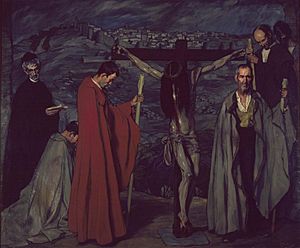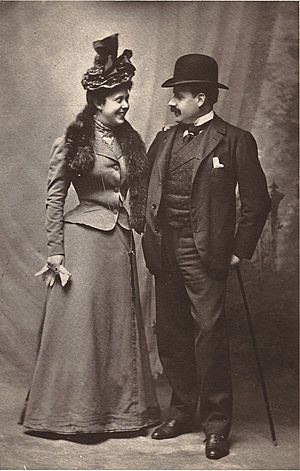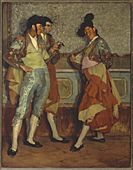Ignacio Zuloaga facts for kids
Quick facts for kids
Ignacio Zuloaga
|
|
|---|---|
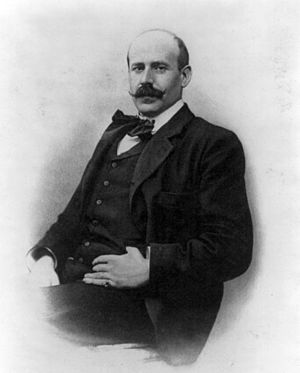
Ignacio Zuloaga in 1909
|
|
| Born |
Ignacio Zuloaga y Zabaleta
July 26, 1870 |
| Died | October 31, 1945 (aged 75) |
| Nationality | Spanish |
| Known for | Painting |
Ignacio Zuloaga y Zabaleta (born July 26, 1870 – died October 31, 1945) was a famous Spanish painter. He was born in Eibar, a town in Spain.
Contents
Zuloaga's Family History
Ignacio came from a family of skilled metalworkers. His father, Plácido Zuloaga, was a metalworker who specialized in damascening. This is a special art where different metals are inlaid into each other.
Ignacio's grandfather, Eusebio Zuloaga, managed the royal armoury in Madrid. An armoury is a place where weapons and armor are made or stored. His uncle was Daniel Zuloaga, who was also an artist.
Becoming a Painter
When he was young, Ignacio helped in his father's workshop. His family's metalwork was well-known across Europe. However, Ignacio's father wanted him to have a different career, perhaps in business or engineering.
But during a short trip to Rome with his father, Ignacio decided he wanted to be a painter. He was only 18 years old when he moved to Paris to study art. His first painting was shown in Paris in 1890.
Life in Paris and Spain
Ignacio lived in Paris for five years. He met other artists there, like Paul Gauguin and Henri de Toulouse-Lautrec. Even though he was around these modern artists, Ignacio was always drawn to painting Spanish culture and traditions.
After some time, he moved back to Spain. He lived in cities like Seville and Segovia. Here, he developed his own style of painting. He focused on realistic Spanish scenes, using earthy colors. His art reminded people of older Spanish painters like Diego Velázquez.
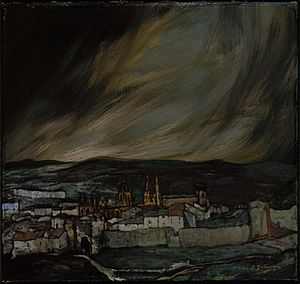
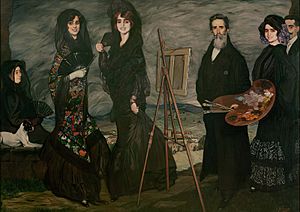
Zuloaga's Art Style
Zuloaga often painted portraits of bullfighters and flamenco dancers. He also painted people from villages, like dwarves and beggars. These figures often appeared against plain landscapes or town backgrounds.
He liked to use dark or muted colors, such as maroon, black, and gray. Sometimes, he would add bright colors for folk costumes or religious robes.
Ignacio Zuloaga married Valentine Dethomas on May 18, 1899. Her brother, Maxime Dethomas, was also an artist and a friend of Zuloaga.
Exhibitions and Famous Works
In 1900, one of Zuloaga's paintings, Before the Bull-fight, was not chosen for a big art show in Brussels. However, it was later bought by a modern art gallery there. His paintings were also shown at the Venice Biennale in Italy in 1901 and 1903. In 1907, he displayed 34 paintings at an exhibition in Barcelona.
One of his most famous paintings is Cristo de la Sangre (Christ of the Blood). This painting shows a powerful and serious side of Spain. Another painting, The Flagellants (1900), also shows a religious scene. A writer named Miguel de Unamuno praised these paintings. He said they showed a "religious and tragic, a black Spain."
Some of Zuloaga's paintings can be seen in American art collections. For example, the Johns Hopkins University's Evergreen Museum & Library in Baltimore, Maryland, has several of his works. These include portraits and Spanish landscapes.
An Iberia airline Airbus A340-642 plane is named after him.
During and After the Spanish Civil War
During the Spanish Civil War, Zuloaga supported the Nationalist side. He even painted a portrait of their leader, Francisco Franco, in 1940.
In 1936, Zuloaga honored the defenders of the Siege of the Alcázar. This was a famous event where Nationalist soldiers refused to give up a building, even when it was on fire. This event became a symbol of strength for the Nationalists.
In 1939, Zuloaga's painting of the Alcázar was shown next to Picasso's Guernica at an art show in London. Zuloaga's painting showed a direct, realistic style, while Guernica was a more modern, symbolic work.
After Zuloaga died in 1945, his image appeared on Spain's 500 peseta banknote in 1954.
Gallery
-
Portrait of Anita Ramírez in Black (around 1915), Brooklyn Museum
See also
 In Spanish: Ignacio Zuloaga para niños
In Spanish: Ignacio Zuloaga para niños


